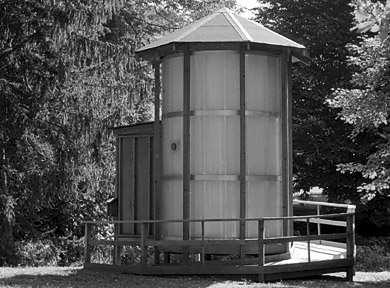I Thought It Would Be Darker...
Recently we went to the Morris Arboretum for an afternoon visit. The Arboretum features some non-botanical attractions integrated into the landscape, including a garden railway and a number of sculptures. Tucked away off the beaten track is the small building pictured below. It’s a camera obscura, not something you see every day—or any day, for that matter.
Camera obscura means “dark room” in Latin. An apt choice of name, both for language (since camera obscuras probably date to a time when people actually spoke Latin) and because a dark room is really all it is. A dark room with a hole, that is. Light from outside passes through the hole and through the magic of physics (or is it the reverse?) forms an upside-down image on the opposite wall. (See Wikipedia or this appreciation for more information.) This camera obscura is cylindrical and is equipped with two lenses on opposite sides so that the entire interior is covered with a panoramic image of the garden.
I had never seen a camera obscura before, so I wasn’t sure what to expect. I assumed that the image would be very dim, and that it would take some time to become accustomed to the darkness. On the contrary, I was surprised at how bright the image was—no adjustment required. The brightness was due no doubt to the large aperture (which was fitted with a lens). Unfortunately, large apertures sacrifice depth of field to achieve brightness, so much of the image was out of focus. Even with that defect, it was a new visual experience similar to yet quite unlike watching a movie in a theater. Taking a picture of it is impossible, since much of the charm comes from the fact that the image is moving.
The Arboretum’s camera obscura was created by artist Richard Torchia. He calls the installation “A Key to the Garden,” and it really does open a door to a unique view of the garden.

Camera obscura by Richard Torchia at Morris Arboretum.

